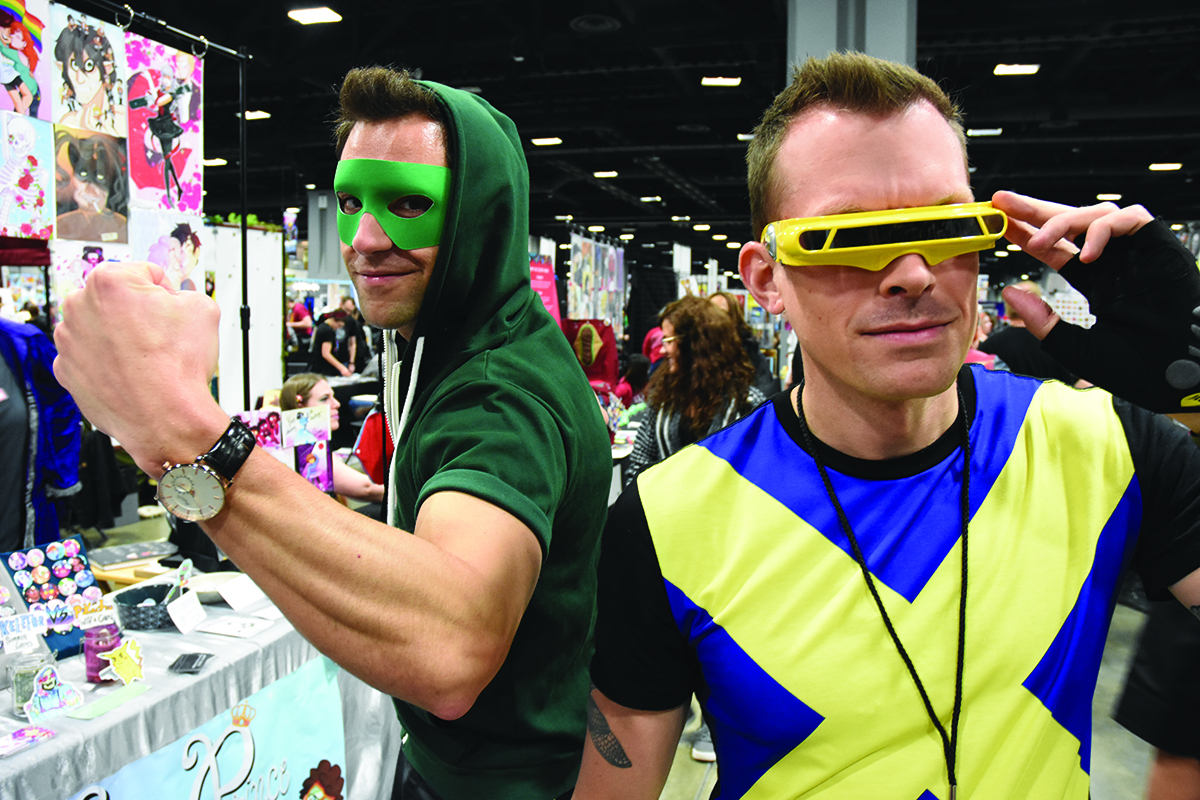Batman: Arkham Knight (Review)
Batman: Arkham Knight isn’t perfect, but it reminds us just how good a superhero game can be

Time doesn’t seem to be a definitive thing in Batman: Arkham Knight (![]()
![]()
![]()
![]() ). Over the course of the game’s narrative, you’re constantly bombarded with a sense of urgency. “Hurry,” the plot will tell you, “you must rush to the next task, complete the subsequent objective, and conclude this next chapter in our story!”
). Over the course of the game’s narrative, you’re constantly bombarded with a sense of urgency. “Hurry,” the plot will tell you, “you must rush to the next task, complete the subsequent objective, and conclude this next chapter in our story!”
That’s perfectly acceptable. I like a game where it always feels as though someone is stoking the furnace that powers the plot. If it wants me to just get on with things and work through the story, so be it. However, what developer Rocksteady has done is provide a gargantuan recreation of Gotham City, cram it full of as many side missions and distractions as possible, tell you that you really should be cracking on with the main missions, and then bombard you with optional objectives like illuminated billboards in Times Square. “Stop swinging about, Bats!” they cry. “Who cares about Scarecrow, come solve another Riddler mystery!”
I realize, of course, that none of the above even approaches a legitimate complaint. It’s merely a curious side effect of my time with Arkham Knight, when I realized that I’d spent far more time either dicking around in Gotham’s criminal-infested streets or working through its numerous side missions than I had concentrating on the story’s main event. Yes, the narrative may be urgent, by my desire to complete it was anything but.
If you haven’t played either of Arkham Knight’s predecessors, Arkham Asylum and Arkham City, don’t worry. There’s a great deal of backstory and lore, established through those two prior entries, but it’s entirely possible for new players to jump into the narrative, understand what’s going on, and still enjoy their time in Gotham.
It helps that Rocksteady are masterful craftsmen (and women). Arkham Knight has three intertwining threads to its narrative this time around. First, there’s the Joker. Cremated by Batman after the antics of Arkham City, his Titan-infused blood was used to infect the Dark Knight — which means that, yes, Mark Hamill’s incredible Joker returns. How? Thanks to Scarecrow. Furious with Bats for thwarting his plans in Arkham City, he returns to Gotham intending to wreak havoc. After threatening the city with the release of a toxin that will turn people into savage beasts, Gotham is evacuated, leaving it to the brave officers of the Gotham Police Department and a laundry list of Batman’s various nemeses. Batman is exposed to Scarecrow’s toxin, which combines with Joker’s blood to produce hallucinations of the smiling ne’erdowell. Hamill claimed he was done with the character after Arkham City, but his personification of the Joker is so utterly delicious that I’m glad he returned.

Coupled with this is the inclusion of the mysterious — and eponymous — Arkham Knight. Commanding a large militia and with an encyclopedic knowledge of Bruce Wayne’s moves and abilities, uncovering his identity is one of the plot’s core goals. As Batman fights Scarecrow’s attempts to spread toxin across the East Coast, Arkham Knight seeks to end his life at every turn. Combined with Joker’s constant chatterings and comments on his efforts, it makes for an interesting narrative, to say the least.
Really, though, it’s entirely arbitrary — the Arkham Knight reveal is teased to the point that I had stopped caring, and Scarecrow spends most of the game telling you that he will destroy you, to the point that you wish he’d just, well, get on with it. I won’t decry Rocksteady’s storytelling — it’s comic book, after all — but it’s in the side missions that you’ll derive most of your enjoyment from Arkham Knight.
That is, at least in part, due to the sheer number of things to do. There are firefighters to rescue, a serial killer to catch, a mysterious creature to track down, bombs to defuse, and a variety of villainous actions to thwart, which prompt appearances from Riddler, Two-Face, Penguin, Deathstroke and Firefly. Riddler alone has 243 riddles scattered around Gotham — an initially daunting task, until you remember that Arkham City had over 400. Plus, getting 100-percent completion isn’t just for achievement hunters. If you want to unlock the full ending to the game, you’ll need to completely clear Gotham out of side missions and optional objectives before you learn everything Arkham Knight has to reveal.
Tackling that laundry list of missions is aided by the game’s immensely fun controls. Yes, Batman isn’t the easiest person to control — after all, he’s over six feet tall and two-hundred pounds of muscle — but, he’s amazingly agile for someone so hulking. Once you’ve mastered the numerous button presses it requires to get Bats into combat or around his environment, you’ll be punching, diving, swooping, flying and grappling with the best of them.
Navigating Gotham is perhaps the game’s greatest showcase. A city of over six million, it’s now eerily derelict, with abandoned vehicles, scattered debris and all the other hallmarks of a rushed evacuation. Perhaps more impressive is that, despite this, the city never feels empty. Criminals roam the streets, racing cars, fighting with police, and shooting at Batman as he soars above them. They’re joined by drones, in tank and plane form. In addition, Gotham’s incredible police force is still showing face, with helicopters and squad cars found throughout the city.

The city itself is rendered beautifully — Rocksteady makes use of the extra power afforded by the current generation of consoles to really push graphics to their limits. Gotham’s lights burst into the cloudy night sky, rain drips down every surface (including Batman’s armor, a seriously cool effect), shadows are menacingly deep and every inch of the city smacks of the dirty sheen we’ve come to expect from Batman’s dark, grimy world. Character models are fantastically rendered, while combat sections are a masterclass in animation, with Batman’s body and cape whipping around in sync as he lands punches on unsuspecting foes.
Audio is impeccable, too, with a surprising amount of in-game chatter on offer. As you navigate Gotham radio signals will be detected, with criminals and villains offering commentary on in-game events and hints as to the location of nearby objectives. Cutscenes feature a solid effort from all voice actors — Kevin Conroy can do little more than gruffly shout “Where is she/he/it!” as Batman, but Mark Hamill as the Joker, Wally Wingert’s Riddler and Martin Jarvis’ Alfred are just a few highlights of the main cast. Combat audio, in-game score and all other incidental effects combine to make Arkham Knight a suitably rich, enveloping experience.
While gliding through its streets and marvelling at its content is one thing, it would all fall apart had Rocksteady messed with this Batman series’ core hook: an astonishingly deep, rich gameplay experience. Thankfully, they haven’t — at least when Batman is on foot (or mid-air).
Combat is as deft as ever, with the usual combo counter and a slick skillset enabling Batman to produce a stunning variety of attacks. Use explosive gel to incapacitate enemies, take them out with a batarang, sneak up behind someone and silently take them down, string them up from a gargoyle’s head, slide through ventilation shafts and leap out of grates, or enter slow-motion quick-time events to take down multiple enemies at once — known as the Fear takedown. Using Batman’s various gadgets only adds to the fun, such as an electrical charge gun, or a freezing blast (no shark repellent, unfortunately). Occasionally, in tighter sections, the game can get a little messy — the camera falters, or it’s not entirely clear where villains are facing in gloomier environments, for instance — but for the vast majority of the game, you’ll enjoy working your way through Gotham’s criminals.

There’s a wide variety, too, with average joes, heavy brutes, sword-wielding ninjas and numerous other characters who will vainly attempt to take down Bats. Winning isn’t easy — countering is a must, but later battles will require using gadgets, or Batman’s stun ability, before you can finally vanquish a foe. Grappling into an environment, opening up Bats’ detective vision to scan for body signatures, then planning your method of attack offers a constant variety to gameplay. Do you go stealthy, or head in with Batarangs and grapple attacks? Leave traps for unsuspecting thugs, or silently pick them off from larger groups? It’s immensely satisfying.
That is, of course, until you’re inevitably forced into the Batmobile, perhaps one of the most contrived inclusions in gaming in recent memory. If someone asked me whether I’d like to use a rocket-powered, armored beast to crash through Gotham, I’d scream an unequivocal “Yes!” After my time with Arkham Knight, I’m strongly considering cutting up my driver’s license, as I’ve lost all love for piloting a vehicles.
It’s not as though there aren’t some great ideas here. The Batmobile is an almost-indestructible tank, which Batman can use to carry criminals or friends, that can deploy a winch to tear down walls or charge up generators, and can transform into an actual tank, complete with rocket launcher and machine gun. Gotham City is surprisingly destructible, and crashing through city streets tearing up road signs, walls, pillars and other structures feels awesome. The Batmobile is badass, and can be summoned from anywhere in the city thanks to its remote driving capabilities. Unfortunately, rather than keep its uses to a minimum, drip-feeding it to players and keeping its gameplay fresh, Rocksteady has instead shoehorned it in at every possible occasion.
On a list of things you don’t ever want to do in-game in a car, platforming is definitely one of them. Using tank mode, which offers more nimble maneuvering and strafing abilities, Rocksteady constantly forces you to navigate small ledges, ramps, jumps and other such things with the Batmobile. Far, far too many of Riddler’s challenges employ the Batmobile as their central conceit, which quickly becomes utterly tiresome, as you crash off that third ledge for the fourteenth time. What’s more, after a few upgrades navigating Gotham isn’t any faster in the Batmobile — your grapple and zip line become so overpowered that you can slingshot around the city like Spider-Man, rendering the Batmobile obsolete. Even blowing up unmanned drones becomes utterly tedious, as, unlike enemies, whatever new type is introduced offers little extra challenge beyond taking a few extra shots to blow up.

That the drones are unmanned fails to mask one glaring flaw in this game — Batman definitely kills people. I’m sorry, Rocksteady, but when I drive into a criminal at what must be close to 100 miles per hour, you’re not fooling anyone by suggesting that his lifeless body was harmlessly pushed out of the way by an electric field around the Batmobile. Heck, even in combat I struggle to believe that ninety percent of the people I’ve hit aren’t dead. Batman socks them with such strength, or leaps down on them from such great heights, that their bones would be crushed to smithereens. Rocksteady seems all too aware of this, as the plot even references Bats’ destructive tendencies — the Joker also has some highly amusing quips about his non-lethal mantra.
Of course, this is a game, and a game based on a comic book at that, so perhaps asking for reality is more than a little foolish. And besides, I couldn’t care less as outside of the obvious body count and the annoying dependence on the Batmobile, Arkham Knight is still an incredible amount of fun. Even seemingly banal moments, like using Batman’s detective vision to scan through the layers of a serial killer’s victim, are infused with such quality that you can’t help but enjoy them.
It seems fitting that Rocksteady should end the trilogy with Arkham Knight. It’s an impressive effort from a series that’s already no stranger to praise. Though Rocksteady could be accused of dropping the ball in a couple of places, Arkham Knight’s positives greatly outweigh any Batmobile annoyances or questionable morals. Gamers can easily sink thirty hours into Gotham City and there’s incentive to replay its story to test out different methods of attack. It’s an immensely polished, impeccably crafted, utterly enjoyable final entry from a series that has raised the bar for what we expect from superhero games.
Arkham Knight is available on PS4 and Xbox One. PC sales have been suspended at the time of this review due to a botched porting job by Iron Galaxy Studios that has left the game riddled with technical faults.
Support Metro Weekly’s Journalism
These are challenging times for news organizations. And yet it’s crucial we stay active and provide vital resources and information to both our local readers and the world. So won’t you please take a moment and consider supporting Metro Weekly with a membership? For as little as $5 a month, you can help ensure Metro Weekly magazine and MetroWeekly.com remain free, viable resources as we provide the best, most diverse, culturally-resonant LGBTQ coverage in both the D.C. region and around the world. Memberships come with exclusive perks and discounts, your own personal digital delivery of each week’s magazine (and an archive), access to our Member's Lounge when it launches this fall, and exclusive members-only items like Metro Weekly Membership Mugs and Tote Bags! Check out all our membership levels here and please join us today!

























You must be logged in to post a comment.